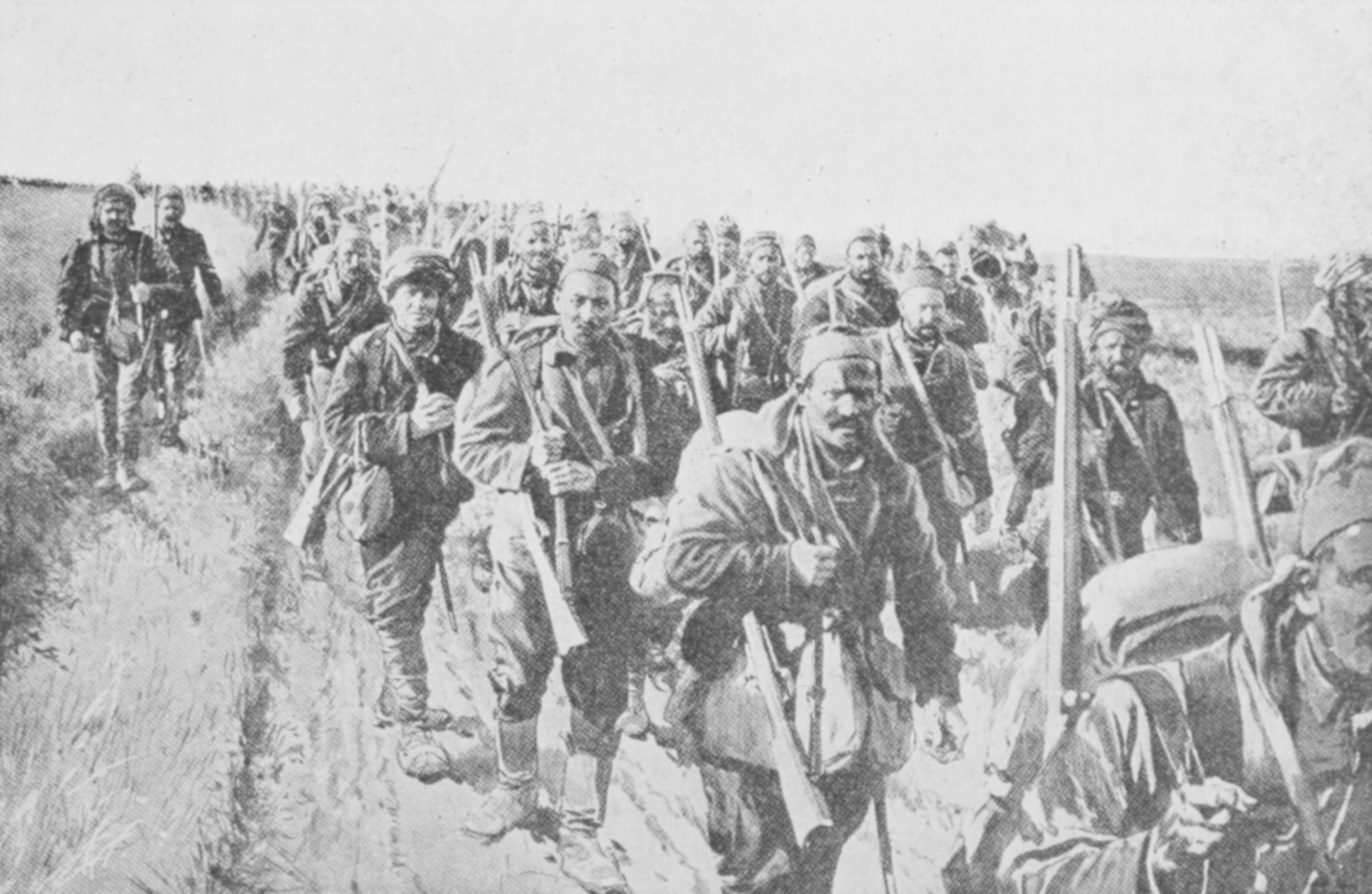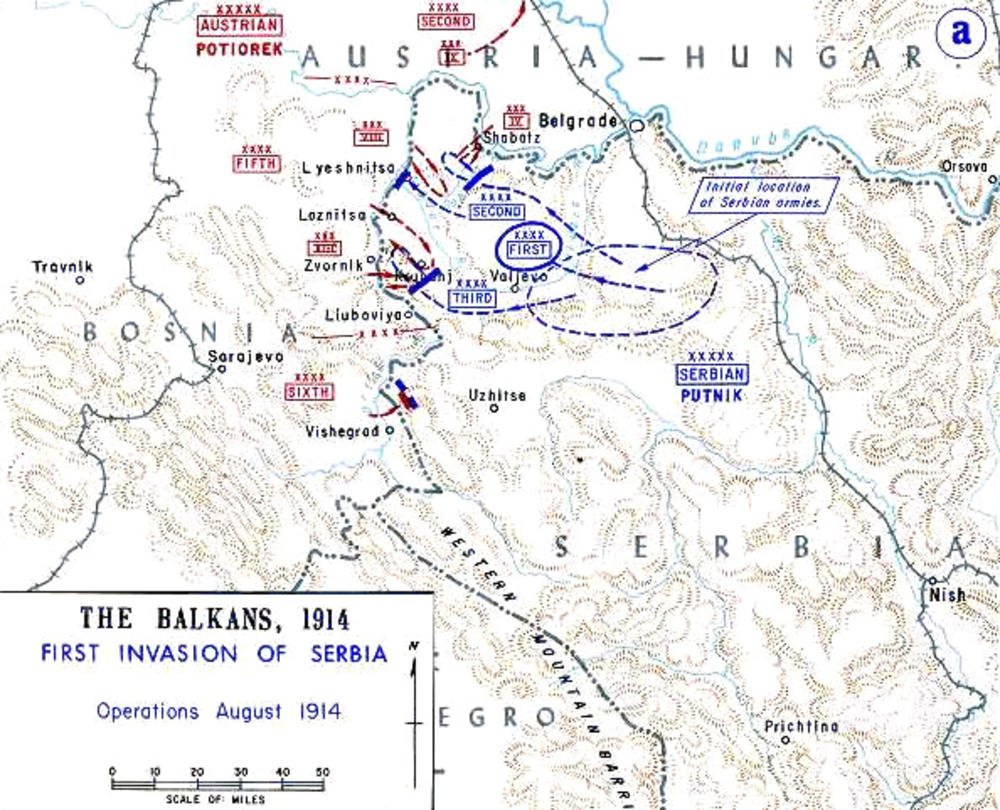|
Åœivojin MiÅ¡iÄ
Åœivojin MiÅ¡iÄ ( sr-cyrl, ÐОвПÑОМ ÐОÑОÑ; 19 July 1855 â 20 January 1921) was a field marshal who participated in all of Serbia's wars from 1876 to 1918. He directly commanded the First Serbian army in the Battle of Kolubara and in breach of the Thessaloniki Front was the Chief of the Supreme Command. He is the most decorated Serbian military officer in history. Early years MiÅ¡iÄ was born in Struganik near Mionica. His parents Radovan and AnÄelija had thirteen children. Åœivojin was the youngest child, and when he was born, only eight of his brothers and sisters were still alive. When he turned six, he became a shepherd. He finished primary school in Kragujevac. In 1868, he started his gymnasium education in Kragujevac, where he finished his primary schooling and part of his secondary, before completing the rest in Belgrade. He was admitted to the Military Academy in 1874. In late 1884, he married a German woman, Louise Krikner (1865-1956), at Ascension ... [...More Info...] [...Related Items...] OR: [Wikipedia] [Google] [Baidu] |
Vojvoda (Serbia And Yugoslavia)
Vojvoda ( sr-Cyrl, ÐПÑвПЎа ) from old Serbian was the highest rank in the army of the Kingdom of Serbia and Kingdom of Yugoslavia from 1901 until end of Second World War in 1945. It has roots from the medieval term Voivode used during medieval Kingdom, Empire and Principality of Serbia. Vojvoda in medieval and later principality of Serbia had similar meaning as Duke title in other feudal states as it was military and noble title. In modern military terms the rank of Vojvoda is comparable with Field marshal and Generalfeldmarschall but since it can be an honorable title it is not always a military rank of a commissioned military officer. It was first created with the passing of the law on the ''Organization of the Army'' of the Kingdom of Serbia in 1901 and later confirmed in Kingdom of Yugoslavia laws on the ''Organization of the Army and Navy'' from 1923 and 1929. Law from 1901 was passed on the suggestion of Lieutenant colonel (later Divisional General) MiloÅ¡ VasiÄ ... [...More Info...] [...Related Items...] OR: [Wikipedia] [Google] [Baidu] |
Thessaloniki Front
The Macedonian front, also known as the Salonica front (after Thessaloniki), was a military theatre of World War I formed as a result of an attempt by the Allied Powers to aid Serbia, in the autumn of 1915, against the combined attack of Germany, Austria-Hungary and Bulgaria. The expedition came too late and with insufficient force to prevent the fall of Serbia and was complicated by the internal political crisis in Greece (the National Schism). Eventually, a stable front was established, running from the Albanian Adriatic coast to the Struma River, pitting a multinational Allied force against the Bulgarian army, which was at various times bolstered with smaller units from the other Central Powers. The Macedonian front remained stable, despite local actions, until the Allied offensive in September 1918 resulted in Bulgaria capitulating and the liberation of Serbia. Background Following the assassination of Archduke Franz Ferdinand by a Bosnian Serb, Austria-Hungary had att ... [...More Info...] [...Related Items...] OR: [Wikipedia] [Google] [Baidu] |
Battle Of Kolubara
The Battle of Kolubara ( sr-Cyrl, ÐПлÑбаÑÑка бОÑка, ) was fought between Austria-Hungary and Serbia in November and December 1914, during the Serbian Campaign of 1914. It commenced on 16 November, when the Austro-Hungarians under the command of Oskar Potiorek reached the Kolubara river during their third invasion of Serbia that year, having captured the strategic town of Valjevo and forced the Serbian army to undertake a series of retreats. The Serbs withdrew from Belgrade on 29â30 November, and the city soon fell under Austro-Hungarian control. On 2 December, the Serbian army launched a surprise counterattack all along the front. Valjevo and UÅŸice were retaken by the Serbs on 8 December. The Austro-Hungarians retreated to Belgrade, which 5th Army commander Liborius Ritter von Frank deemed untenable. The Austro-Hungarians abandoned the city between 14 and 15 December and retreated into Austria-Hungary, allowing the Serbs to retake their capital the followi ... [...More Info...] [...Related Items...] OR: [Wikipedia] [Google] [Baidu] |
Serbian Campaign (1914)
The Serbian campaign of 1914 was a significant military operation during World War I. It marked the first major confrontation between the Central Powers, primarily Austria-Hungary, and the Allies of World War I, Allied Powers, led by the Kingdom of Serbia. The campaign started on 28 July 1914, when July Crisis#Austria-Hungary declares war on Serbia (28 July), Austria-Hungary declared war on Serbia and Bombardment of Belgrade (1914), bombarded Belgrade. On 12 August, the Austro-Hungarian Army, Austro-Hungarian forces, led by General Oskar Potiorek, launched their first offensive into Serbia. The Austro-Hungarian forces, known as BalkanstreitkrÀfte and consisting of the 5th Army (Austria-Hungary), 5th and 6th Army (Austria-Hungary), 6th Armies, attacked Serbia from the west and north. The Royal Serbian Army, Serbian army under the command of General Radomir Putnik using their knowledge of the rugged terrain and the strategic advantage of the rivers, defeated the 5th Army at the Bat ... [...More Info...] [...Related Items...] OR: [Wikipedia] [Google] [Baidu] |
World War I
World War I or the First World War (28 July 1914 â 11 November 1918), also known as the Great War, was a World war, global conflict between two coalitions: the Allies of World War I, Allies (or Entente) and the Central Powers. Fighting took place mainly in European theatre of World War I, Europe and the Middle Eastern theatre of World War I, Middle East, as well as in parts of African theatre of World War I, Africa and the Asian and Pacific theatre of World War I, Asia-Pacific, and in Europe was characterised by trench warfare; the widespread use of Artillery of World War I, artillery, machine guns, and Chemical weapons in World War I, chemical weapons (gas); and the introductions of Tanks in World War I, tanks and Aviation in World War I, aircraft. World War I was one of the List of wars by death toll, deadliest conflicts in history, resulting in an estimated World War I casualties, 10 million military dead and more than 20 million wounded, plus some 10 million civilian de ... [...More Info...] [...Related Items...] OR: [Wikipedia] [Google] [Baidu] |
Battle Of Bregalnica
The Battle of Bregalnica was fought between the armies of the Kingdom of Bulgaria and the Kingdom of Serbia during the Second Balkan War The Second Balkan War was a conflict that broke out when Kingdom of Bulgaria, Bulgaria, dissatisfied with its share of the spoils of the First Balkan War, attacked its former allies, Kingdom of Serbia, Serbia and Kingdom of Greece, Greece, on 1 ... from 30 June to 8 July. It was the largest battle of the war. Gallery Bitka kaj Krivolak, Timocka divizija i bugarski trupi kaj Krivolak, 1913.JPG, Telegram from PaÅ¡iÄ to London, about the success of Timok Division suppressing Bulgarian troops in Krivolak. (June 24, 1913) References Sources * Savo Skoko ''Vojvoda Radomir Putnik Vol.1''; Beogradsko GrafiÄko-IzdavÄki Zavod, 1984. * Notes * The numbers of the strength of Serbian Army do not indicate the exact strength of the forces deployed during the Battle of Bregalnica but rather the entire strength of the Serbian Army in Macedonia ( ... [...More Info...] [...Related Items...] OR: [Wikipedia] [Google] [Baidu] |
Second Balkan War
The Second Balkan War was a conflict that broke out when Kingdom of Bulgaria, Bulgaria, dissatisfied with its share of the spoils of the First Balkan War, attacked its former allies, Kingdom of Serbia, Serbia and Kingdom of Greece, Greece, on 16 (Old Style, O.S.) / 29 (N.S.) June 1913. Serbian and Greek armies repulsed the Bulgarian offensive and counterattacked, entering Bulgaria. With Bulgaria also having previously engaged in territorial disputes with Kingdom of Romania, Romania and the bulk of Bulgarian forces engaged in the south, the prospect of an easy victory incited Romanian intervention against Bulgaria. The Ottoman Empire also took advantage of the situation to regain some lost territories from the previous war. When Romanian troops approached the capital Sofia, Bulgaria asked for an armistice, resulting in the Treaty of Bucharest (1913), Treaty of Bucharest, in which Bulgaria had to cede portions of its First Balkan War gains to Serbia, Greece and Romania. In the Trea ... [...More Info...] [...Related Items...] OR: [Wikipedia] [Google] [Baidu] |
Battle Of Bitola
The Battle of Monastir took place near the town of Bitola, Macedonia (then known as Monastir) during the First Balkan War, between Serbian and Ottoman forces from 16 to 19 November 1912. It resulted in a Serbian victory after heavy fighting north of the city, the routed Turks fled abandoning their guns. Battle As an ongoing part of the Balkan Wars, the Ottoman Vardar Army retreated from the defeat at Kumanovo and regrouped around Bitola. The Serbs seized Skopje then sent forces to help their Bulgarian ally besiege Adrianople. The Serbian 1st Army, advancing south on Monastir (modern Bitola), encountered heavy Ottoman artillery fire and had to wait for its own artillery to arrive. According to French Captain G. Bellenger, writing in ''Notes on the Employment of Artillery in the Balkan Campaign'', unlike the Ottomans, Serbian field artillery was very mobile, at some point the Serbian Morava Division dragged four long-range artillery pieces up a mountain, then each night hau ... [...More Info...] [...Related Items...] OR: [Wikipedia] [Google] [Baidu] |
Battle Of Kumanovo
The Battle of Kumanovo (Serbian: ÐÑЌаМПвÑка бОÑка / Kumanovska bitka, Turkish: Kumanova Muharebesi), on 23â24 October 1912, was a major battle of the First Balkan War. It was an important Serbian victory over the Ottoman army in the Kosovo Vilayet, shortly after the outbreak of the war. After this defeat, the Ottoman army abandoned the major part of the region, suffering heavy losses in manpower (mostly due to desertions) and in war materiel. Background The objective of the Royal Serbian Army plan was to destroy the Ottoman army in a decisive battle before the Ottomans could complete the mobilisation and concentration of forces. The Serbian planners assumed that the main Ottoman force would be deployed defensively in the valley of Vardar and on the strategically important plateau of OvÄe Pole. The Serbian Commander-in-Chief was General Radomir Putnik. The aim was to double envelop the Ottoman army by using three armies: * First Army, under Crown Princ ... [...More Info...] [...Related Items...] OR: [Wikipedia] [Google] [Baidu] |


